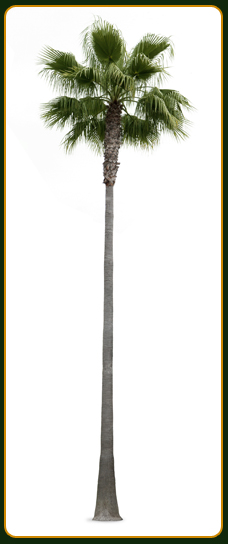Technical Data
Washingtonia robusta

Scientific or Latin name: Washingtonia robusta.
Common names:Washingtonia, Wachintona, Mexican Palm, Pritchardia, Pichardia, Mexican Fan Palm.
Family:Arecaceae (former name: Palmaceae).
Origin: Native to the Mexican and Californian northwest
Etymology:Genus name in honor of George Washington (1732-1799), first President of the United States of America; the scientific name ‘robusta’ is given because of its being the biggest among the Pritchards’. It is the most quickly growing, more rustic and cheapest palm tree.
Particular features: The bark is grayish brown. The leaves are very big and up to 2 m in diameter and in a bright green color; the old leaves do not have any veins or ‘threads’ or have very few of them. The dead leaves remain adhered to the palm tree and fall towards the trunk. It has small white hermaphrodite flowers and small brown fruits less than 1 cm in diameter. It is planted in groups and lines; it is apt to be planted in big tondos.
Cultivation:It is a rustic species that tolerates very well transplanting and lack of water as well as poor soils.
Light: It needs plenty of sunlight.
Temperatures: Washingtonia robusta can resist frost down to -5ºC; Washingtonia filiferas are more resistant (down to -10ºC). Under these temperatures some leaves could whither but they sprout again. Trunk bases of young trees have to be protected against frost.
Soil conditions: It adapts to multifarious soil conditions.
Watering: It is drought resistant. It needs watering in the summer season to grow properly.
Transplanting: It is very resilient when transplanted even under naked root conditions.
Multiplication: It multiplies from seed. These germinate easily.